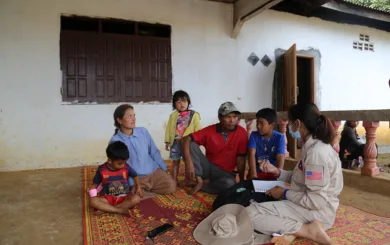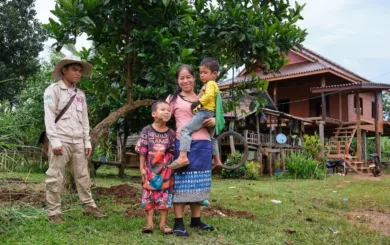Country Context
Lao PDR holds the unfortunate distinction of being the most heavily bombed country per capita in history. Between 1964 to 1973, over two million tonnes of ordnance were dropped during 580,000 bombing missions – equivalent to one planeload of bombs every eight minutes, 24 hours a day, for nine years.
While a reliable estimate of cluster munition and other explosive ordnance (EO) contamination in Lao PDR is not available yet, the level of contamination is classed as ‘massive’. Cluster munition contamination is among the highest in the world when measured against the population, posing significant risks to livelihoods, socio- economic development, and quality of life in affected communities.
According to the current national mine action strategy, “Safe Path Forward III” (2021–2030), there have been at least 50,000 confirmed casualties caused by explosive ordnance since the 1964 to 1973 Indochina war ended. Of these, 30,000 were fatal.
Lao PDR is a state party to the Convention on Cluster Munitions (CCM), being not only one of the convention’s first signatories but also an early champion of it. Under CCM’s Article 4, which requires clearance of all areas known to be contaminated by cluster munitions, the country has a completion deadline set to 2030.
According to the Mine Action Review, as of the end of 2023, nearly 1,996km² of confirmed hazardous areas (CHAs) in Laos had been identified through ongoing Cluster Munition Remnants Survey (CMRS). This represents an increase from the nearly 1,745km² reported at the end of 2022. In 2023, submunition clearance totalled 56.67km², with 58,382 submunitions destroyed.
Country Programme
The programme in Lao PDR is one of the biggest in the NPA’s Mine Action and Disarmament portfolio, with a budget of approximately USD $13.8 million for 2025 and employing over 1,000 national staff as of February 2025.
NPA has been operating in Lao PDR since 1997. For the first 10 years, NPA supported the national clearance operator, UXO Lao, with technical assistance and quality assurance, before starting its own operations in Saravane province in 2009.Notably, in August 2023, NPA commenced its first explosive ordnance risk education (EORE) activities, collaborating closely with local communities, particularly but not only, focusing on children, to raise awareness about the EO contamination in Lao PDR. This involves educating people about the various types of EO, the associated risks, and safe behaviour when encountering EO, and the process of reporting any discovery of such.
By the end of 2023, NPA had successfully doubled its operational capacity, supported by increased funding from the Government of the United States and continued contributions from the Government of Norway.
Currently, NPA is one of the largest mine action operators in Lao PDR, deploying eight survey teams, 41 clearance teams, and four EORE teams across Champasak, Sekong, Attapeu, and Saravane provinces.
Additionally, NPA continues to work with the National Regulatory Authority (NRA) on an Information Management (IM) capacity development project. The initiative aims to enhance the NRA's IM capacity at all levels by training staff, developing key documents, improving the IM system, and addressing the quality of historical UXO data in Lao PDR.
Overall results
Since the start of the programme until 31 December 2024, NPA’s Lao PDR programme has:
- Surveyed more than 644 km² and identified more than 4,598 contaminated tasks covering a total size of over 319 km².
- Cleared over 53 km² of contaminated land in 872 tasks.
- Destroyed more than 162,500 items of UXO through survey and clearance of confirmed hazardous area.
- Secured safe access to land, directly benefitting nearly 170,780 persons and indirectly benefitting 337,646 persons, further enabling development efforts.
Fast Facts
- Lao PDR was one of the first countries to sign the Convention on Cluster Munitions in 2008, and the treaty entered into force in 2010. Lao PDR was instrumental in the treaty's negotiations, and actively works to promote universalization of the treaty.
- Fourteen of the country’s 18 provinces, and up to a quarter of the villages in Lao PDR, are severely contaminated with cluster munitions and other unexploded ordnance.
- Lao PDR has suffered the highest recorded number of cluster munitions casualties per capita in the world.
- At least 186 different types of munitions have been found in Lao PDR.
- As at the end of 2022, a total of almost 1,745 km2 of cluster munition contaminated area had been identified through technical survey.
- While Lao PDR does not yet have a comprehensive or reliable estimate of nation-wide contamination, survey efforts to fully define the extent of contamination, and to help prioritize the areas of highest need for clearance, are ongoing.
- The remote location of many mined areas entails that mines have little impact and are not currently a clearance priority of Lao PDR (of 81,646 items of explosive ordnance destroyed in 2021, only 56 - less than 0.07% - were mines). However the NRA has observed that “with a steady expansion of land use ‘mined areas’ will become areas for growing concern.”
Achievements 2024
From 1 January to 31 December 2024, the NPA Lao PDR programme:
- conducted 849 EORE sessions in 62 targeted villages
- cleared over 11 km2 of previously UXO and CMR-contaminated areas on102 tasks
- found and safely destroyed over 13,121 items of explosive ordnance (EO)
- surveyed nearly 9.9 km2 and identified 63 Confirmed Hazardous Areas covering more than 3.4 km2
- secured safe access to land, directly benefitting over 19,671 persons.
- Lao PDR Profile in the Landmine and Cluster Munition Monitor
- NPA Lao PDR on Facebook






